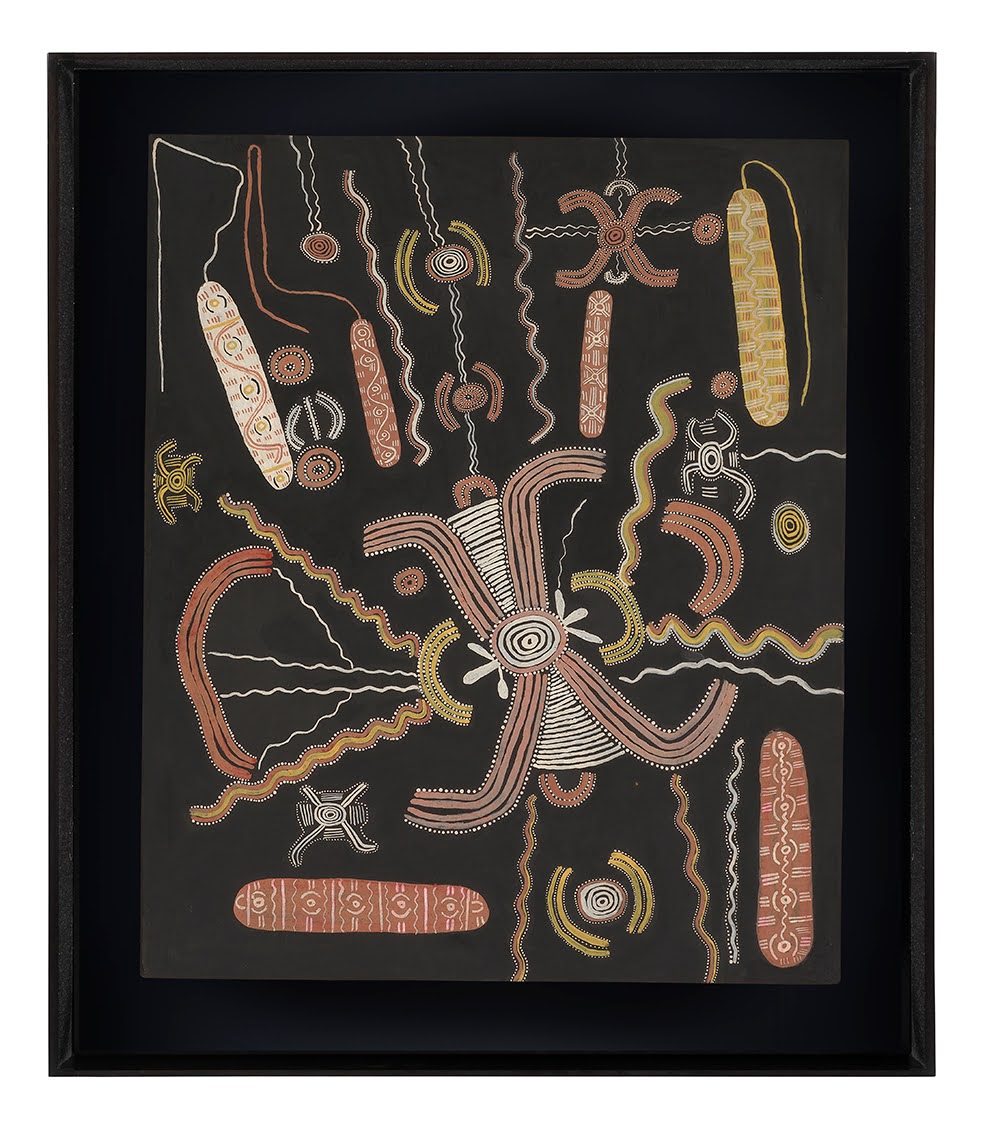|
TEFAF Maastricht
Booth 431
Maastricht, NL | March 15–20, 2025
Maastricht, Netherlands, February 19, 2025 – D’Lan Contemporary is delighted to announce that it will participate in TEFAF Maastricht 2025 with a curated selection of works by Australia’s preeminent First Nations artists, including Declan Apuatimi, Paddy Bedford, Rover Thomas Joolama, Emily Kam Kngwarray, Mick Namarari Tjapaltjarri, and Carlene West, among others. D’Lan contemporary is the first Australian gallery to present a major exhibition of First Nations art at TEFAF.
The presentation will explore the profound connection between First Nations artists and their ancestral lands, revealing how these artists translate their cultural heritage and lived experiences into powerful visual narratives. For example, while painting Wallaby Sign for Men and Women (1971) in Papunya in the Northern Territory of Australia, Mick Namarari Namarari (c. 1926–1998) was musing on his ancestral country far to the west. The work was made in an era when painting materials were largely unfamiliar to First Nations artists, and their technique was fluid and evolving quickly. Namarari was essential to trialing and inventing new ways to represent ancient ceremonies through 20th-century painting.
Declan Apuatimi (c. 1930–1985) was one of the Tiwi Island’s most prominent artists. His work Purrukuparli (1979) is an interpretation of the ancestral figure of the same name, who picked up the dead body of his son and, walking backwards into the sea, decreed that death should come to the whole world. The pronouncement was a wrathful punishment for his wife absconding into the bush to make love with another man, which resulted in her son dying of exposure to the hot sun. Apuatimi’s haunting interpretation of Purrakaparli—mouth agape with a vacant stare—captures his own despair upon learning of the death of his son, Jinani. In the figure, Purrakaparli stands decorated with jilamara (traditional designs) that continue to be worn by Tiwi ceremonial performers.
Also featured are two major paintings, Untitled–Summer Transition (1991) and Awelye II (1995), by Emily Kam Kngwarray (c. 1910–1996). Both works were painted at Delmore Downs, a large property and cattle station to the southeast of Alhalker, the desert country of her birth.
Kngwarray painted Untitled–Summer Transition in March, the beginning of the southern autumn. Here, the sharp, tight clusters of dots that appeared in her earlier works begin to enlarge and soften in a new technique that captures the scale and breadth of the anwerlarr (yam) tubers as well as the emu’s activity above ground, which is connected to the crop’s increase and propagation.
Awelye II was painted in September 1995 during Kngwarray’s final stylistic period, characterized by tangled painterly strokes, replacing her previous practice of repetitive dotting with the more economic qualities of the line. These pared-back late works also show Kngwarray exploring the female body’s increased role in ceremonies, such as through the use of body paint on the breasts and arms.
Staying faithful to while also advancing East Kimberley painting traditions, Goowoomji Nyunkuny Paddy Bedford (c. 1922–2007) created an experimental, minimalist, abstract visual language that brought East Kimberley painting to the world. In Mendoowoorrji-Medicine Pocket (2004), one of the two paintings D’Lan Contemporary is bringing to TEFAF, Bedford evokes the creation narrative of a hillscape important to his country as a camping spot for Gija families before the arrival of Europeans. He suggests the tale’s ‘living water,’ which can be found along these hills, by the luminosity and transparency of the paint, achieved through his wet-on-wet technique that requires a fast method of application. D’Lan Contemporary is proud to be the Gallery Representative of The Estate of Paddy Bedford, supporting his dying wish to allocate a portion of the profits to maintaining and preserving the traditional Gija language.
About D’Lan Contemporary
D’Lan Contemporary was founded in 2016 by D’Lan Davidson, a prominent art consultant and gallerist who has specialised in Australian First Nations art for over 20 years.
Representing the country’s most distinctive and dynamic art movement, the gallery presents regular exhibitions of modern and contemporary art by leading and emerging First Nations artists at its galleries in Melbourne, Sydney, and New York, alongside an international programme of exhibitions, educational talks and events that celebrate and promote the rich art and culture of Australia’s first peoples.
D’Lan Contemporary maintains strict ethical practices and is committed to generating positive industry change to create a sustainable marketplace for this important segment of Australian art and culture. The gallery contributes 30% of its net profits to artists and their communities.
D’LAN CONTEMPORARY MELBOURNE
40 Exhibition Street
Open Tuesday–Saturday, 10am–5pm + Saturday 11am–4pm
Melbourne / Naarm VIC 3000 Australia
–
D’LAN CONTEMPORARY SYDNEY
97-99 Queen Street
Open Tuesday–Saturday, 10am–5pm + Saturday 11am–4pm
Sydney / Gadigal NSW 2025
–
D’LAN CONTEMPORARY NEW YORK
25 East 73rd Street
Open Tuesday–Saturday, 11am–6pm
New York, NY 10021 USA
dlancontemporary.com.au
# # #
FOR MEDIA ENQUIRIES
For International Requests:
Max Kruger-Dull
Tel: +1-212-675-1800
Blue Medium, Inc.
max@bluemedium.com
For Australian Requests:
Nicole Kenning
Tel: +44 7739 519 290
D’Lan Contemporary
nicole@dlancontemporary.com.au |

